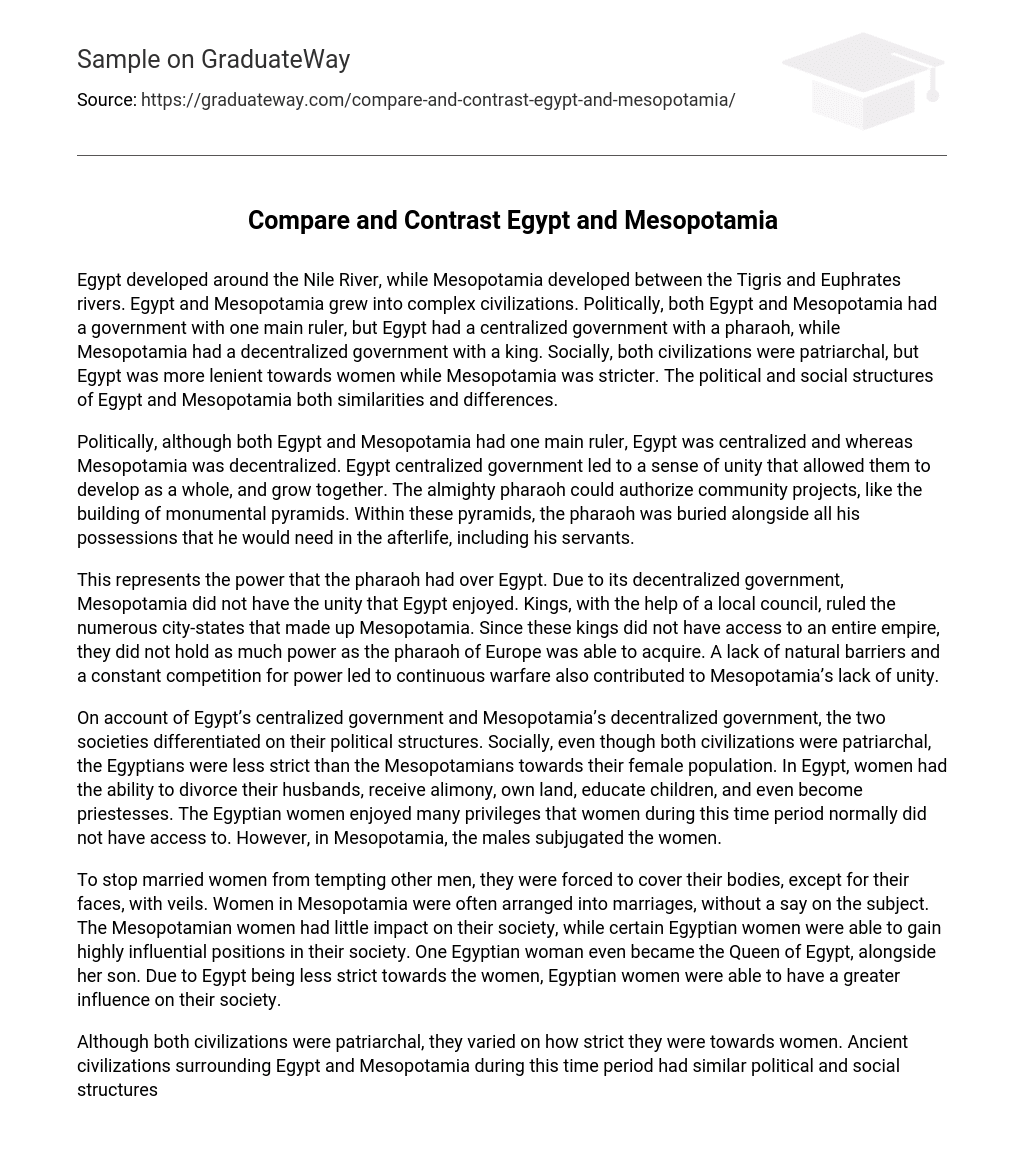Egypt developed around the Nile River, while Mesopotamia developed between the Tigris and Euphrates rivers. Egypt and Mesopotamia grew into complex civilizations. Politically, both Egypt and Mesopotamia had a government with one main ruler, but Egypt had a centralized government with a pharaoh, while Mesopotamia had a decentralized government with a king. Socially, both civilizations were patriarchal, but Egypt was more lenient towards women while Mesopotamia was stricter. The political and social structures of Egypt and Mesopotamia both similarities and differences.
Politically, although both Egypt and Mesopotamia had one main ruler, Egypt was centralized and whereas Mesopotamia was decentralized. Egypt centralized government led to a sense of unity that allowed them to develop as a whole, and grow together. The almighty pharaoh could authorize community projects, like the building of monumental pyramids. Within these pyramids, the pharaoh was buried alongside all his possessions that he would need in the afterlife, including his servants.
This represents the power that the pharaoh had over Egypt. Due to its decentralized government, Mesopotamia did not have the unity that Egypt enjoyed. Kings, with the help of a local council, ruled the numerous city-states that made up Mesopotamia. Since these kings did not have access to an entire empire, they did not hold as much power as the pharaoh of Europe was able to acquire. A lack of natural barriers and a constant competition for power led to continuous warfare also contributed to Mesopotamia’s lack of unity.
On account of Egypt’s centralized government and Mesopotamia’s decentralized government, the two societies differentiated on their political structures. Socially, even though both civilizations were patriarchal, the Egyptians were less strict than the Mesopotamians towards their female population. In Egypt, women had the ability to divorce their husbands, receive alimony, own land, educate children, and even become priestesses. The Egyptian women enjoyed many privileges that women during this time period normally did not have access to. However, in Mesopotamia, the males subjugated the women.
To stop married women from tempting other men, they were forced to cover their bodies, except for their faces, with veils. Women in Mesopotamia were often arranged into marriages, without a say on the subject. The Mesopotamian women had little impact on their society, while certain Egyptian women were able to gain highly influential positions in their society. One Egyptian woman even became the Queen of Egypt, alongside her son. Due to Egypt being less strict towards the women, Egyptian women were able to have a greater influence on their society.
Although both civilizations were patriarchal, they varied on how strict they were towards women. Ancient civilizations surrounding Egypt and Mesopotamia during this time period had similar political and social structures to either of the civilizations. Most societies with a centralized government did not see their rulers as divine as pharaohs. Some civilizations, like the Chinese rulers and their Mandate of Heaven, ruled with a power similar to the Egyptian pharaohs. However, the Chinese empire could also be overthrown if they were a bad ruler.
The Greek city-states also constantly fought each to gain power over all of Greece. Socially, ancient civilizations were not as lenient towards their women. Since social inequalities developed starting around the development of agriculture, women of ancient times were treated as inferior subjects. Globally during this time period, civilizations tended to vary from centralized to decentralized governments, with different opinions when it came to the female population. Egypt and Mesopotamia had similarities and differences pertaining to their political and social structures.
While both civilizations had one main ruler, Egypt was united under a centralized government and Mesopotamia was divided into city-states with a decentralized government. Both civilizations were patriarchal, but Egypt was a lot less strict towards women than Mesopotamia. Outline of CC Rewrite I. Thesis Paragraph * Thesis: The political and social structures of Egypt and Mesopotamia both similarities and differences. * Road Map: Politically, both Egypt and Mesopotamia had a government with one main ruler, but Egypt had a centralized government with a pharaoh, while Mesopotamia had a decentralized government with a king.
Socially, both civilizations were patriarchal, but Egypt was more lenient towards women while Mesopotamia was stricter. II. Body Paragraph #1 – Political Similarities and Differences * Topic Sentence: Politically, although both Egypt and Mesopotamia had one main ruler, Egypt was centralized and whereas Mesopotamia was decentralized. * Comparison: Both have one main ruler * Contrast #1: Egypt centralized while Mesopotamia decentralized * Contrast #2: Egypt unified while Mesopotamian city-states fought for power. III.
Body Paragraph #2 – Social Similarities and Differences * Topic Sentence: Socially, even though both civilizations were patriarchal, the Egyptians were less strict than the Mesopotamians towards their female population. * Compare: Both patriarchal * Contrast #1: The various freedoms Egyptian women had, versus the subjugation of Mesopotamian women. * Contrast #2: Egyptian women could have greater impact on society, like Egyptian Queen. Mesopotamian women controlled much more by men. IV. Relating to larger global context Topic sentence: Ancient civilizations surrounding Egypt and Mesopotamia during this time period had similar political and social structures to either of the civilizations. * Compare Political: Civilzations like China also had very powerful rulers like Egypt. Civilizations like Greece had city-states that constantly fought for power. * Compare Social: Most civilizations looked down on women due to inequalities that developed with the rise of agriculture. V. Conclusion * Egypt and Mesopotamia had similarities and differences pertaining to their political and social structures.





